High geopressure gradient and initial production rates cause an overall rapid decline in production, with first-year decline rates up to 80%.
Fred P. Wang and Ursula Hammes, University of Texas at Austin
The Haynesville Shale in North Louisiana and East Texas is a unique North American gas shale play. With a geopressure gradient of more than 0.9 psi/ft and high average porosity ranging from 8% to 14%, it has also become one of the most productive gas shales, with about 2 Bcfd produced from about 440 wells. Because of its high porosity, low connate water saturation and relatively low total organic content (TOC), most free gas is stored in the inorganic mudrock matrix. In addition to natural fractures and high pressure, high calcite and quartz contents, ranging from 14% to 35%, can further enhance the shale’s brittleness.
One of the unique features of Haynesville production is that significantly less frac water than injected has flowed back during production. The loss of frac water has made water a critical issue in the area. The objectives of this study are to investigate the origin of low connate water saturation and its impacts on fluid flow in the Haynesville Shale.
GEOLOGY
The Upper Jurassic Haynesville Shale is an organic-rich mudstone that was deposited in a partly restricted basin related to a worldwide transgression. It is surrounded by carbonate platforms and islands in the south and west, and by clastic shelves in the north and northeast.1 The Haynesville unconformably overlies carbonates and evaporites of the Smackover, Buckner and Haynesville lime formations and is overlain by the siliciclastic-dominated shales and sandy shales of the Bossier Formation. Structurally influenced by the Cretaceous Sabine uplift and salt tectonics of the North Louisiana and East Texas salt basins, this formation dips from 10,000 ft of depth in the northeast to more than 14,000 ft in the west and south.
Paleogeography influences mineral composition that varies considerably in the main play area. The shale in the northern and northwestern part of the play is more clay- and siliciclastic-rich, whereas carbonate content and total organic content (TOC) increase further to the south and west due to proximity to carbonate platforms and due to restriction by Paleozoic structures such as the Sabine Island complex.1,2
FORMATION PRESSURE
One of the unique characteristics of the Haynesville Shale is that it is highly geopressured. The high pressure gradient tends to enhance porosity, gas content and apparent brittleness of gas shales. It increases gas content through the increases in porosity and gas density. Although, intrinsically, the Haynesville Shale is not as brittle as the Barnett Shale of Fort Worth Basin, Texas, the near-fracture-gradient formation pressure makes the effective stress (lithostatic pressure minus pore pressure) of the Haynesville Shale very low and, thus, makes the formation easy to frac.
Because of the extremely low permeabilities of gas shales, static bottomhole pressures cannot be determined, and shut-in tubing, shut-in casing or flowing casing pressures are normally reported in well tests. Bottomhole pressures of Haynesville Shale wells along with those of high-pressure wells of the Haynesville limestone and Bossier sand/shale were estimated from test data and mapped in Fig. 1. Pressure increases from 7,000 psi in Harrison County, Texas, to over 10,000 psi in San Augustine and Nacogdoches Counties, Texas, and Red River Parish, Louisiana. They are equivalent to pressure gradients from 0.6 psi to more than 0.95 psi/ft, with an average of 0.8 psi/ft.
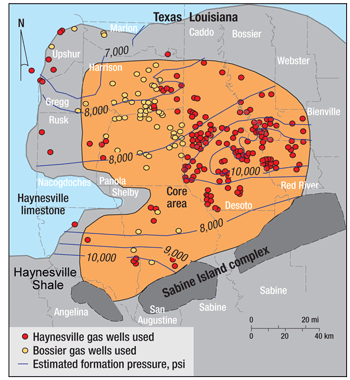 |
|
Fig. 1. Pressure contours in the Haynesville Shale producing area showing increasing pressure toward the south and east within the core area.
|
|
Using more than 7,000 pressure data points (from the IHS database) from Travis Peak to Smackover reservoirs, the pressure-depth relationship in the East Texas/North Louisiana salt basin was plotted, Fig. 2. Wells with pressures less than the hydrostatic pressure gradient (0.45 psi/ft) were deleted. At depths greater than 10,000 ft, not only the Haynesville Shale but also parts of the Cotton Valley, Bossier, Haynesville limestone and Smackover formations are typically moderately to highly geopressured.
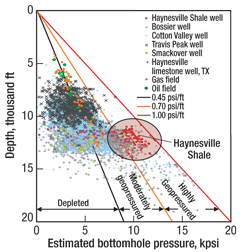 |
|
Fig. 2. The relationship between estimated formation pressure and depth.
|
|
POROSITY AND PERMEABILITY
Because of high porosity and relatively low TOC, the Haynesville Shale is a system dominated by matrix porosity and free gas. Although the estimated percentage of organic pores in the Haynesville Shale is less than 20% of pore volume, organic pores play an important role in petrophysical properties and production.3,4 In gas shales, permeability values measured using crushed samples are usually orders of magnitude lower than those measured using core plugs, because organic and microfracture pore networks, which play critical roles for fluid flow and gas production, are eliminated in crushed samples.4 Despite these shortcomings, because there are potentially useful porosity-permeability trends observed, permeability data from crushed samples are reported in this study.
Figure 3 shows relationships between porosity and matrix permeability from two wells in Harrison and Panola Counties, Texas, measured using 20–35-mesh crushed samples. Permeability in the Haynesville Shale increases from the sub-nanodarcy scale to 1 mD, with core porosity values from 3% to 14%. Averages are 72 nD in permeability and 8.7% in porosity. Data are bounded by the high- and low-permeability trends shown in orange and gray. Permeabilities in the overlying Bossier Shale are extremely low, which could be caused by the differences in mineral composition, as this shale is more argillaceous. Based on the high-permeability trend curve (orange line in Fig. 3), the permeability is expected to be 1,000 nD at a porosity value of 12%, which agrees well with the 400 nD used by Petrohawk for wells in Louisiana.5
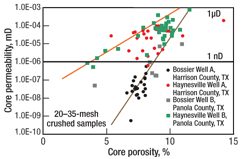 |
|
Fig. 3. The permeability-porosity relationship for two horizontal Haynesville shale wells.
|
|
CONNATE WATER SATURATION
Connate water saturations in high-quality gas shales are low. Connate water saturations from two cored Haynesville Shale wells vary from 15.6% to 40.8% with an average of 27.6% (Fig. 4), which is similar to other high-quality gas shales such as the Barnett, Marcellus and Eagle Ford.6,7 Although data are scattered, they show a weak trend of decreasing connate water saturation with increasing porosity. The low connate water saturations in gas shales may have been caused by the excessive drying of shale at high temperatures and pressures during gas generation and migration, and by the effects of burial history and capillary hysteresis.4,8,9
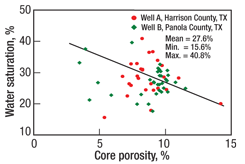 |
|
Fig. 4. Connate water saturation versus porosity for two horizontal wells.
|
|
Low connate water saturation has two important impacts on fluid flow in gas shales: 1) decreased likelihood of water production, and 2) low frac-water recovery. Water produced in gas shale is normally from adjacent aquifers through faults and fractures rather than from the shales themselves.
INITIAL GAS PRODUCTION
Shale quality, gas deliverability and production sustainability determine the success of a shale gas play. Gas content, total organic content, thermal maturity, mineral content and brittleness are the five critical parameters that determine the quality of a gas shale and its productivity. Initial potential, an indicator of deliverability, measures the gas shale quality near the formation volume that is stimulated by a completion. Initial gas potential depends upon gas shale quality and production technology, such as length of horizontal well, frac size, choke size and number of frac stages. For example, the higher the choke size, the higher the initial potential.
Initial gas potential values from 236 Haynesville horizontal wells range 2–31 MMcfd with an average of 13 MMcfd, and 80% of the wells are in the 5–25-MMcfd range, Fig. 5. Initial potentials of wells in Louisiana and Texas are skewed toward 20 MMcfd and 10 MMcfd, respectively, with respective averages of 13.7 MMcfd and 10.5 MMcfd. Wide ranges of well and completion have been tested, including length of horizontal wells from 2,900 ft to 5,700 ft, choke size from 6⁄64 in. to 40⁄64 in., and number of frac stages from 4 to 16. The majority of wells were completed with 4,000–4,500-ft horizontal lengths, 18⁄64–24⁄64-in. choke size and 10–14 frac stages. High initial gas production rates cause large pressure changes in tubing and fractures, and proppant crushing,10 which will reduce EUR. To reduce potential tubing problems, to retain the effectiveness of hydraulic fracturing and to increase EUR, several operators have reduced choke sizes to 14⁄64 in. or 18⁄64 in.
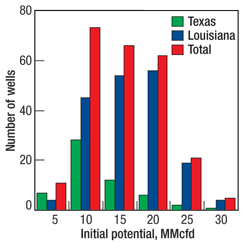 |
|
Fig. 5. Frequency distribution of initial potentials from 236 horizontal wells.
|
|
Figure 6 shows that initial potential increases with depth. This is because factors that can increase gas content, such as pressure, temperature and thermal maturity, increase with depth. In addition, owing to the high pressure gradients, Haynesville Shale porosity may not decrease with depth, and most likely increases with silica and carbonate content.
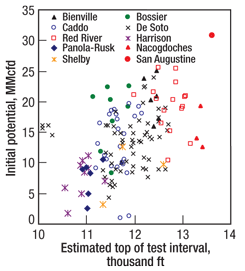 |
|
Fig. 6. The relationship between depth and initial potential for the 236 horizontal Haynesville Shale wells.
|
|
Mineral composition varies considerably across the core area of the Haynesville Shale. Figure 7 shows initial potentials of four production regions (areas I–IV) and mineralogic differences that affect initial potential. Initial potentials are highest in the deep, silica-rich Red River, Bienville and Bossier Parishes in Louisiana and the carbonate-rich Shelby Trough (red highlighted sweet spot), and lowest in the shallow, more clay-rich Harrison and Panola Counties, Texas. Initial potential differences are caused by the combined effects of mineral content, TOC and depth. The higher the silica or carbonate content, the more brittle the shale, and the better for fracture network development and production.
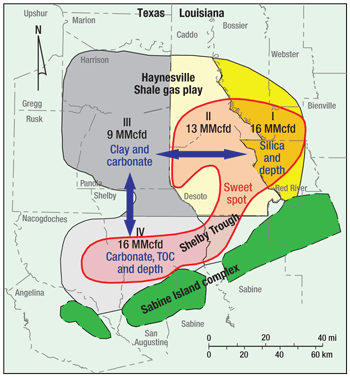 |
|
Fig. 7. Initial potentials of four production areas and factors affecting initial potential in the core area of the Haynesville.
|
|
FLUID-FLOW MECHANISMS
Fluid flow in gas shales is controlled by flow mechanisms at all scales, from microscopic to macroscopic. Fluid-flow mechanisms include free gas flow, desorption, diffusion and imbibition suction.4,11 Free gas flow can be non-Darcy type in both organic and inorganic matrices, as a result of the slippage effect,12 but Darcy type in natural and hydraulic fractures. The gas adsorbed on the organic matter can be produced by desorption and diffusion as pressure and concentration change during production. Imbibition suction, although not well understood, is an intriguing flow mechanism proposed for the phenomenon of the high frac-water retention in gas shales.4
FRAC-WATER RETENTION
There are four important types of fluid flow in both shale gas and tight gas reservoirs: frac fluid, gas, connate water and encroached water. Of these, frac fluid flow is the least understood. In parts of the Barnett Shale, frac water recovery can be as low as 5–30%,13,14 and frac water recovery in the Haynesville is less than 10%.5 This loss of frac water could be caused by the combined effects of gravity segregation in fractures and imbibition suction of frac water. Some frac water is likely retained in the lower part of fractures because, during production, gas tends to flow through the upper part of fractures, and the rest is imbibed into mudrock matrix pores.4
REFRAC
Because of the high geopressure gradient and high initial production rate in the Haynesville Shale, production declines rapidly. The decline rate in the first year can be as high as 80%.6,15 This is caused by the complicated relationship between production and pressure (stress). High production can result in very large stress changes in tubing and fractures.10 The large pressure change in the hydraulic fracture increases the effective stress, and it reduces the permeability of the fracture network, which in turn results in rapid production decline. Therefore, refracing will be needed at a much earlier stage in the Haynesville Shale than in the Barnett Shale. Multiple refrac operations may also be needed to maximize recovery by opening existing and new fractures. 
ACKNOWLEDGMENTS
This article was prepared from AAPG 752831 presented at the AAPG Annual Convention and Exhibition, New Orleans, April 11–14, 2010. The study was funded by the State of Texas Advanced Oil and Gas Resource Recovery (STARR) program and Mudrock Systems Research Laboratory at the Bureau of Economic Geology, Jackson School of Geosciences, University of Texas at Austin. Special thanks to BP in Houston for providing core data. Publication was authorized by the director of the Bureau of Economic Geology.
LITERATURE CITED
1 Hammes, U., Eastwood, R. and H. S. Hamlin, “Influence of facies variations on exploration, production, and resource assessment in gas-shale plays: A geologic and petrophysical evaluation of the Haynesville Shale, East Texas, USA,” poster presented at the AAPG Annual Convention and Exhibition, New Orleans, April 11–14, 2010.
2 Buller, D. and M. C. Dix, “Petrophysical evaluation of the Haynesville Shale in northwest Louisiana and northeast Texas,” Gulf Coast Association of Geological Societies Transactions, 59, 2009, pp. 127–143.
3 Loucks, R. G., Reed, R. M., Jarvie, D. M. and S. C. Ruppel, “Morphology, genesis and distribution of nano scale pores in siliceous mudstones of the Mississippian Barnett Shale,” Journal of Sedimentary Research, 79, 2009, pp. 848–861.
4 Wang, F. P. and R. M. Reed, “Pore networks and fluid flow in gas shales,” SPE 124253-PP presented at the SPE Annual Technical Conference and Exhibition, New Orleans, Oct. 4–6, 2009.
5 Stoneburner, R., “The Haynesville Shale: A look back at the first year,” presented at the 8th Annual Gas Shales Summit, Dallas, Texas, March 30–31, 2009.
6 Chesapeake Energy, presentation at investor and analyst meeting, 2010.
7 Petrohawk Energy, presentation at investor and analyst meeting, 2009.
8 Law, B. E. and W. W. Dickinson, W., “A conceptual model for the origin of abnormally pressured gas accumulations in low-permeability reservoirs,” AAPG Bulletin, 86, No. 4, 1985, pp. 1295–1304.
9 Shanley, K. W., Cluff, R. M. and J. W. Robinson, “Prolific gas production from low-permeability sandstone reservoirs, part II: Reconciling basin history, saturations, shows and capillary pressure,” presented at the AAPG Annual Convention, Long Beach, Calif., April 1–4, 2007.
10 Pope, C., Peters, B., Benton, T. and T. Palisch, “Haynesville Shale: One operator’s approach to well completions in this evolving play,” SPE 125079MS-P presented at the SPE Annual Technical Conference and Exhibition, New Orleans, Oct. 4–6, 2009.
11 Bennion, B. D. and F. B. Thomas, “Formation damage issues impacting the productivity of low permeability, low initial water saturation gas producing formations,” AIME Transactions, 127, 2005, pp. 240–247.
12 Javadpour, F., “Nanopores and apparent permeability of gas flow in mudrocks (shale and siltstone),” Journal of Canadian Petroleum Technology, 48, No. 8, August 2009, pp. 16–21.
13 Johnson, D., “Reservoir characterization improves stimulation, completion practices,” Oil & Gas Journal, 102, No. 4, Jan. 26, 2004, pp. 60–63.
14 Leonard, R., Woodroof, R. and K. Bullard, K., “Barnett Shale completions: A method for accessing new completion strategy,” SPE 110809 presented at the SPE Annual Technical Conference and Exhibition, Anaheim, Calif., Nov. 11–14, 2007.
15 Petrohawk Energy, presentation at investor and analyst meeting, 2010.
|
THE AUTHORS
|
 |
Fred Wang is a Research Scientist in the Bureau of Economic Geology at the University of Texas at Austin. He holds MS and PhD degrees in petroleum engineering from the University of Texas at Austin, Texas, and Stanford University, California, respectively. Before rejoining the bureau in 1999, he worked at Petroleum Geoservices. Dr. Wang specializes in reservoir characterization and production and fluid flow in conventional and unconventional reservoirs.
|
|
 |
Ursula Hammes obtained her diploma in geology from the University of Erlangen, Germany, in 1987 and her PhD from the University of Colorado at Boulder in 1992. She spent 10 years working as a consultant, performing postdoctoral research at the Bureau of Economic Geology (BEG), and as an exploration geologist in the industry. Dr. Hammes joined the BEG in 2001 as a Research Associate. Her main research focus is in clastic and carbonate sequence stratigraphy, depositional systems, and carbonate and clastic diagenesis. She is currently Project Manager of the State of Texas Advanced Resource Recovery (STARR) project.
|
|











